Janik-Vasily Benzin
Synchronizing Process Model and Event Abstraction for Grounded Process Intelligence (Extended Version)
May 29, 2025Abstract:Model abstraction (MA) and event abstraction (EA) are means to reduce complexity of (discovered) models and event data. Imagine a process intelligence project that aims to analyze a model discovered from event data which is further abstracted, possibly multiple times, to reach optimality goals, e.g., reducing model size. So far, after discovering the model, there is no technique that enables the synchronized abstraction of the underlying event log. This results in loosing the grounding in the real-world behavior contained in the log and, in turn, restricts analysis insights. Hence, in this work, we provide the formal basis for synchronized model and event abstraction, i.e., we prove that abstracting a process model by MA and discovering a process model from an abstracted event log yields an equivalent process model. We prove the feasibility of our approach based on behavioral profile abstraction as non-order preserving MA technique, resulting in a novel EA technique.
From Internet of Things Data to Business Processes: Challenges and a Framework
May 14, 2024



Abstract:The IoT and Business Process Management (BPM) communities co-exist in many shared application domains, such as manufacturing and healthcare. The IoT community has a strong focus on hardware, connectivity and data; the BPM community focuses mainly on finding, controlling, and enhancing the structured interactions among the IoT devices in processes. While the field of Process Mining deals with the extraction of process models and process analytics from process event logs, the data produced by IoT sensors often is at a lower granularity than these process-level events. The fundamental questions about extracting and abstracting process-related data from streams of IoT sensor values are: (1) Which sensor values can be clustered together as part of process events?, (2) Which sensor values signify the start and end of such events?, (3) Which sensor values are related but not essential? This work proposes a framework to semi-automatically perform a set of structured steps to convert low-level IoT sensor data into higher-level process events that are suitable for process mining. The framework is meant to provide a generic sequence of abstract steps to guide the event extraction, abstraction, and correlation, with variation points for plugging in specific analysis techniques and algorithms for each step. To assess the completeness of the framework, we present a set of challenges, how they can be tackled through the framework, and an example on how to instantiate the framework in a real-world demonstration from the field of smart manufacturing. Based on this framework, future research can be conducted in a structured manner through refining and improving individual steps.
INEXA: Interactive and Explainable Process Model Abstraction Through Object-Centric Process Mining
Mar 27, 2024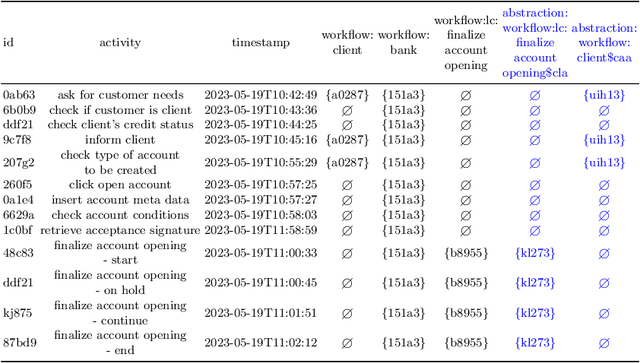

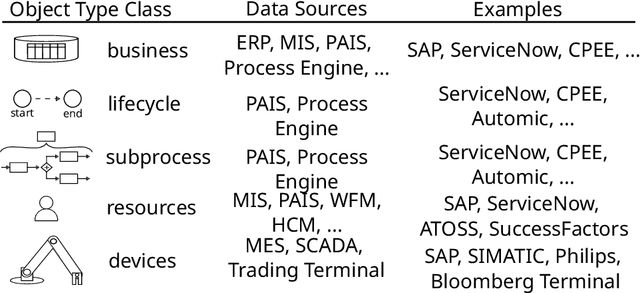

Abstract:Process events are recorded by multiple information systems at different granularity levels. Based on the resulting event logs, process models are discovered at different granularity levels, as well. Events stored at a fine-grained granularity level, for example, may hinder the discovered process model to be displayed due the high number of resulting model elements. The discovered process model of a real-world manufacturing process, for example, consists of 1,489 model elements and over 2,000 arcs. Existing process model abstraction techniques could help reducing the size of the model, but would disconnect it from the underlying event log. Existing event abstraction techniques do neither support the analysis of mixed granularity levels, nor interactive exploration of a suitable granularity level. To enable the exploration of discovered process models at different granularity levels, we propose INEXA, an interactive, explainable process model abstraction method that keeps the link to the event log. As a starting point, INEXA aggregates large process models to a "displayable" size, e.g., for the manufacturing use case to a process model with 58 model elements. Then, the process analyst can explore granularity levels interactively, while applied abstractions are automatically traced in the event log for explainability.
Conversational Process Modelling: State of the Art, Applications, and Implications in Practice
Apr 19, 2023Abstract:Chatbots such as ChatGPT have caused a tremendous hype lately. For BPM applications, it is often not clear how to apply chatbots to generate business value. Hence, this work aims at the systematic analysis of existing chatbots for their support of conversational process modelling as process-oriented capability. Application scenarios are identified along the process life cycle. Then a systematic literature review on conversational process modelling is performed. The resulting taxonomy serves as input for the identification of application scenarios for conversational process modelling, including paraphrasing and improvement of process descriptions. The application scenarios are evaluated for existing chatbots based on a real-world test set from the higher education domain. It contains process descriptions as well as corresponding process models, together with an assessment of the model quality. Based on the literature and application scenario analyses, recommendations for the usage (practical implications) and further development (research directions) of conversational process modelling are derived.
Preventing Object-centric Discovery of Unsound Process Models for Object Interactions with Loops in Collaborative Systems: Extended Version
Mar 31, 2023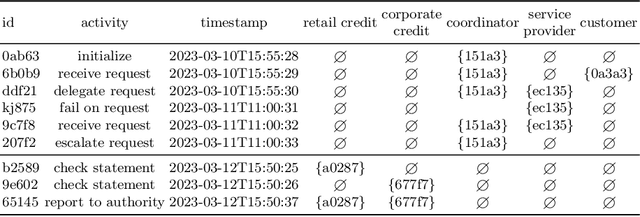


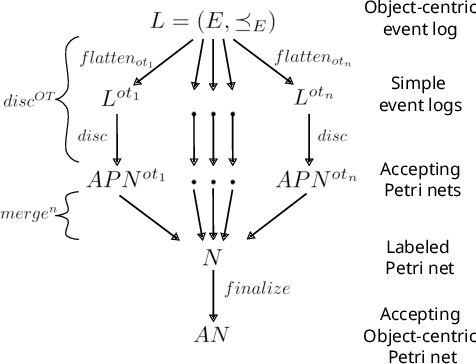
Abstract:Object-centric process discovery (OCPD) constitutes a paradigm shift in process mining. Instead of assuming a single case notion present in the event log, OCPD can handle events without a single case notion, but that are instead related to a collection of objects each having a certain type. The object types constitute multiple, interacting case notions. The output of OCPD is an object-centric Petri net, i.e. a Petri net with object-typed places, that represents the parallel execution of multiple execution flows corresponding to object types. Similar to classical process discovery, where we aim for behaviorally sound process models as a result, in OCPD, we aim for soundness of the resulting object-centric Petri nets. However, the existing OCPD approach can result in violations of soundness. As we will show, one violation arises for multiple interacting object types with loops that arise in collaborative systems. This paper proposes an extended OCPD approach and proves that it does not suffer from this violation of soundness of the resulting object-centric Petri nets. We also show how we prevent the OCPD approach from introducing spurious interactions in the discovered object-centric Petri net. The proposed framework is prototypically implemented.
A Survey on Event Prediction Methods from a Systems Perspective: Bringing Together Disparate Research Areas
Feb 08, 2023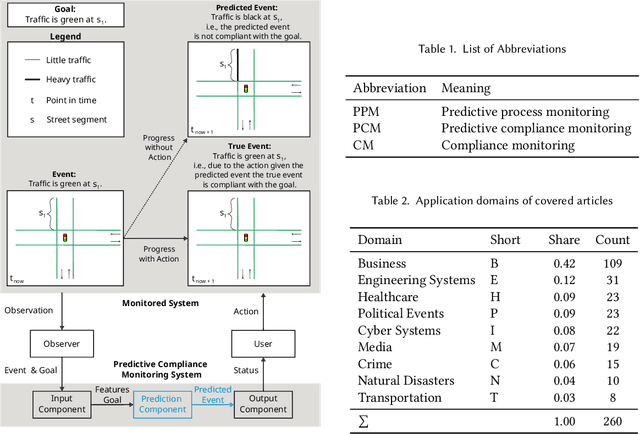

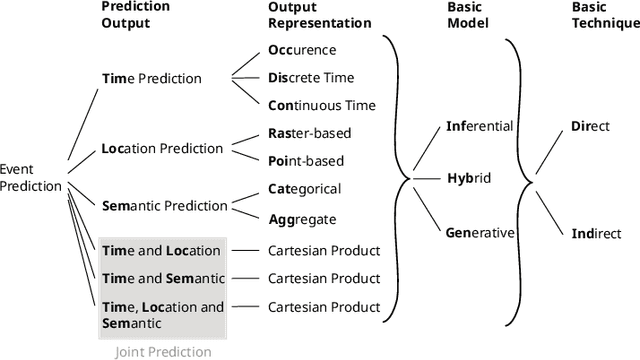
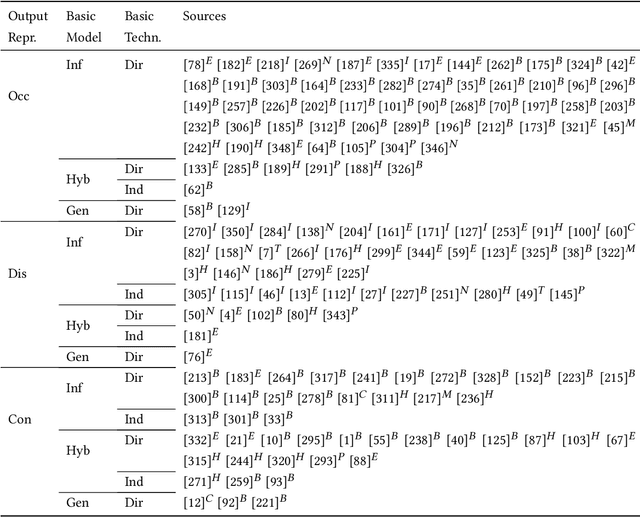
Abstract:Event prediction is the ability of anticipating future events, i.e., future real-world occurrences, and aims to support the user in deciding on actions that change future events towards a desired state. An event prediction method learns the relation between features of past events and future events. It is applied to newly observed events to predict corresponding future events that are evaluated with respect to the user's desired future state. If the predicted future events do not comply with this state, actions are taken towards achieving desirable future states. Evidently, event prediction is valuable in many application domains such as business and natural disasters. The diversity of application domains results in a diverse range of methods that are scattered across various research areas which, in turn, use different terminology for event prediction methods. Consequently, sharing methods and knowledge for developing future event prediction methods is restricted. To facilitate knowledge sharing on account of a comprehensive classification, integration, and assessment of event prediction methods, we combine taxonomies and take a systems perspective to integrate event prediction methods into a single system, elicit requirements and assess existing work with respect to the requirements. Based on the assessment, we identify open challenges and discuss future research directions.
Detecting Context-Aware Deviations in Process Executions
Jun 11, 2022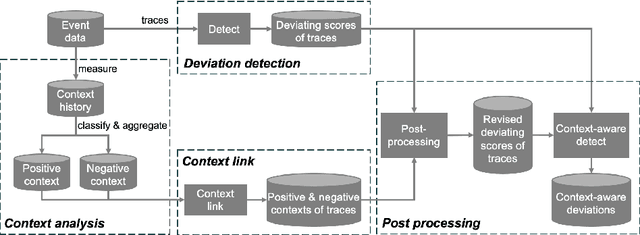

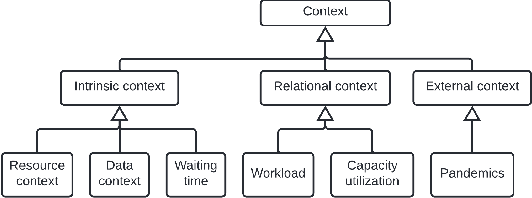
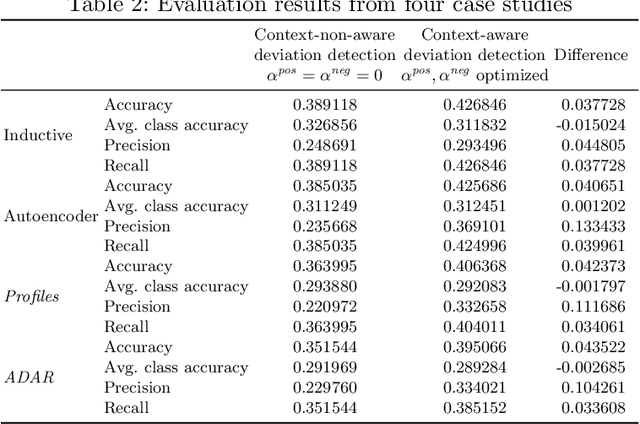
Abstract:A deviation detection aims to detect deviating process instances, e.g., patients in the healthcare process and products in the manufacturing process. A business process of an organization is executed in various contextual situations, e.g., a COVID-19 pandemic in the case of hospitals and a lack of semiconductor chip shortage in the case of automobile companies. Thus, context-aware deviation detection is essential to provide relevant insights. However, existing work 1) does not provide a systematic way of incorporating various contexts, 2) is tailored to a specific approach without using an extensive pool of existing deviation detection techniques, and 3) does not distinguish positive and negative contexts that justify and refute deviation, respectively. In this work, we provide a framework to bridge the aforementioned gaps. We have implemented the proposed framework as a web service that can be extended to various contexts and deviation detection methods. We have evaluated the effectiveness of the proposed framework by conducting experiments using 255 different contextual scenarios.
 Add to Chrome
Add to Chrome Add to Firefox
Add to Firefox Add to Edge
Add to Edge